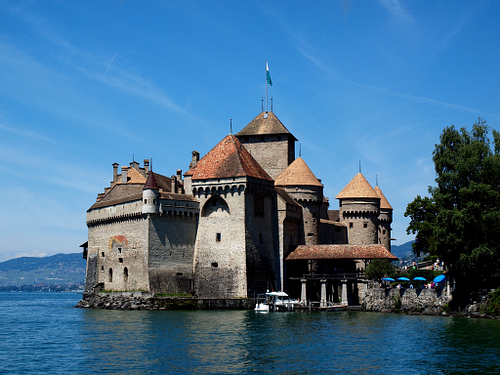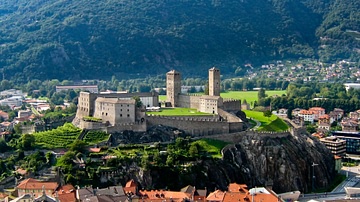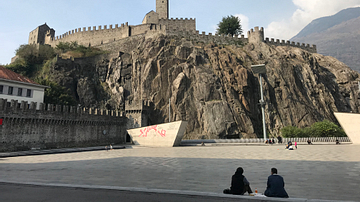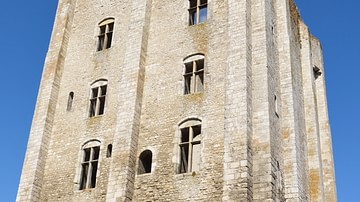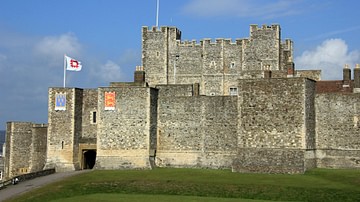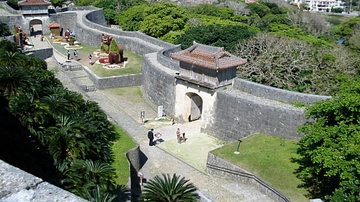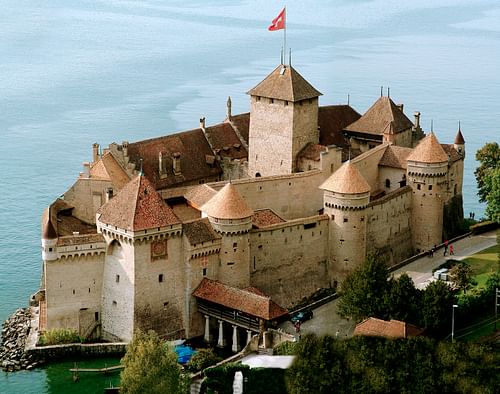
Chillon Castle (French: Château de Chillon) is a medieval fortress celebrated for its beauty and is widely regarded as one of the best-preserved medieval castles in Europe. Situated in Canton Vaud, Switzerland and only 3 km (2 miles) from the modern city of Montreux, Chillon Castle sits on a rock along the banks of Lake Geneva. From the 12th-16th centuries CE, Chillon Castle belonged to the powerful Counts of Savoy who became wealthy as a result of the taxes they imposed on merchants traveling through the area from the Great St. Bernard Pass or on sailing vessels operating on Lake Geneva. Swiss forces from Canton Bern captured Chillon Castle from the Counts of Savoy in 1536 CE, and Chillon Castle has been in Swiss hands since that time. Chillon Castle is today the most visited historic monument in Switzerland with over 400,000 visitors annually.
Geography & Early History
Chillon Castle is located on a rocky islet on the eastern end of Lake Geneva some 40 km (20 miles) east of Lausanne. It is located 3 km (2 miles) east of Montreux in what is now Canton Vaud, Switzerland. The castle offers magnificent views of Montreux as well as the Alps. The Dents du Midi mountains of the Chablais Alps in the neighboring Swiss Canton of Valais provide a dramatic backdrop for the Castle of Chillon, while the waters of Lake Geneva reflect the castle's walls, windows, and turrets.
The Romans were perhaps the first to notice Chillon's prime geographic position, which lay near important Alpine passes. The Romans established a small settlement in the area, but archaeological evidence suggests that human inhabitation along the lakeshore near Chillon dates from the Bronze Age. The Bishops of Sion controlled the site prior to the Counts of Savoy. In the early Middle Ages, the ambitious Counts of Savoy recognized the site's strategic importance due to its access to the Alpine valley of the Rhône River as well as the Simplon Pass, the Mont Cenis Pass, and the Great St. Bernard Pass. Suzerainty over the region ultimately gave the Counts of Savoy control over the flow of trade between what is now France and Germany to Italy over the course of 400 years. Although the first mention of Chillon Castle appears in 1150 CE, it is probable that the castle was constructed several decades earlier in the 11th century CE. The castle keep, or donjon, and the chapel are likely the oldest parts of the castle and date from the late 11th century CE.
The Counts of Savoy consolidated their power over the area in and around Lake Geneva during the 12th and 13th centuries CE, and their rule extended to roughly two-thirds of what is present-day French-speaking Switzerland. In 1214 CE, Count Thomas I founded Villeneuve, located just to the south of the Chillon Castle, which became a port city for trade along Lake Geneva. The castle thus became a very important administrative and financial center in the northern Savoyard lands. Enriched by the profits earned through taxation and conquest, members of the House of Savoy (1003-1946 CE) continued to enlarge the castle, and successive counts reinforced its defensive walls. Counts Thomas I (r. 1189-1233 CE) and Peter II (r. 1263-1268 CE) took special interest in refortifying and strengthening various structures within the castle with the help of the architect, Pierre Mainier. Peter II oversaw a major period of renovation and expansion during the 1240s CE.
While Chillon Castle retained its solid defensive structures in the 13th century CE, Count Peter II also transformed it into a princely residence, inviting members of the local nobility to serve him in state and organize events of pageantry. The foreboding dungeons which would late awe the writers of the Romantic era date from the time of Count Peter's reign, but elegant rooms with exquisite views of Lake Geneva and asymmetrical cobbled courtyards do as well. Visitors to the Castle Chillon can still see paintings on the interior walls that date back to the 13th and 14th centuries CE. While the Counts of Savoy never stayed at the Chillon Castle year-round - they used it primarily as a summer residence - an appointed bailiff stayed at the castle throughout the year to attend to matters of the state on the Count's behalf.
In the 14th and 15th centuries CE, the Counts of Savoy constructed other residences and the Castle of Chillon gradually fell into decline. Later Counts of Savoy transferred Savoyard administrative and financial operations to Chambery, and the royal court moved between Ripaille, Thonon, and Le Bourget. Amadeus VIII (r. 1391 to 1440 CE), reigning as “Duke of Savoy” from 1416 CE onwards, attempted to restore the castle to its golden age during the 13th century CE by sending his chief carpenter, Aymonet Corniaux (c. 1402-1453 CE), to alter tower and wall defenses. His election as Pope Felix V (r. 1439-1449 CE) - Amadeus VIII was to be the last Antipope - prevented him from taking further measures to patronize Chillon Castle.
It is worth noting that the famous Genevan Protestant historian, libertine, and former Catholic monk François Bonivard (1493-1570 CE) was imprisoned at the Chillon Castle by Duke Charles III (r. 1504-1553 CE) from 1530-1536 CE. Bonivard was formerly a Catholic prior of St. Victor in Geneva, but his Protestant zeal and wild personal behavior deeply offended Charles III's staunch Catholic sensibilities. It is said that Charles III ordered Bonivard chained to one of the pillars in Castle Chillon's dungeons. The Bernese later released Bonivard from the dungeons when they captured the castle in 1536 CE. Bonivard's tempestuous life story subsequently served as the chief inspiration for Lord Byron's poem “The Prisoner of Chillon,” which was written in 1816 CE.
Chillon Castle under Bernese Rule
The House of Savoy became weaker due to pressure placed upon it by the rival Habsburg dynasty (1273-1918 CE), which reached a climax during the Italian Wars (1494-1559 CE). Armies from the Protestant Canton Bern in the Swiss Confederation - a historical precursor to what is now modern Switzerland - conquered Vaud from Catholic Savoy and took possession of the Castle of Chillon on 29 March 1536 CE after a short siege of three days. Under the Bernese Swiss, Chillon Castle quietly remained a fortress, depot, and prison for the next 260 years. It operated as a hospital and the Bernese also permitted the castle to become the residence of the bailiff of Vevey.
Although the castle was dilapidated and in need of refurbishment, the Bernese regarded it as both useful and practical. Space within the castle was reorganized to suit the needs of Bernese soldiers and officials, and the Bernese updated the castle's fortifications to allow for the usage of firearms. The Bernese used the dungeons as magazines for Swiss ships, and they also replaced the old, medieval drawbridge with a new one in the early 18th century CE. Despite all of this, the Bernese abandoned Chillon Castle in 1733 CE, relocating to more comfortable lodgings in Vevey. Chillon Castle's upkeep was no longer deemed a military necessity for the Bernese army, and the Chillon Castle became a storage center for transported goods and other materials. There was some suggestion of turning the castle into a large wheat granary in 1785 CE, but this plan never came to pass likely due to the high level of humidity in and around the castle due to the proximity of Lake Geneva.
In 1798 CE, French-speaking citizens from Montreux and Vevey stormed the castle with the help of troops from Revolutionary France, taking it without facing any resistance from the Bernese. The castle's property has belonged to the Canton of Vaud since 1803 CE. The Castle of Chillon was thereafter used to store munitions, including gunpowder, and as a prison. Curiously, the castle continued to house prisoners throughout the 1800s CE who would interact with tourists. At the end of the 19th century CE, the Swiss archaeologist Albert Naef (1862-1936 CE) began the first of a series of ongoing restorations to bring the castle back its former luster. Restoration work continues at the present.
Architecture & Popular Culture
The size and shape of Chillon Castle is reminiscent of a ship - it is 110 m (361 ft) long and 45 m (148 ft) wide at its largest point. The general shape and outline of the castle have remained consistent for nearly 800 years, and Castle Chillon has never been destroyed. Chillon Castle's whitewash exteriors once dazzled visitors, but they have not been repainted. Chillon Castle's donjon is tall, affording expansive views of Lake Geneva and the entire castle as well. Several buildings and two circuits of walls surround Castle Chillon's donjon. The castle contains an impressive four great halls with massive lakeside windows. Medieval historians have noted that Castle Chillon resembles that of Harlech Castle in Wales, especially where it concerns the placement of its large windows. This connection makes sense as Count Peter II was the uncle of Queen Eleanor of Provence (1223-1291 CE) who in turn was the wife of Henry III of England (r. 1207-1272 CE). The Savoyard architect Jacques de Saint-Georges d'Espéranche (c. 1230-1309 CE) worked on the Castle of Chillon before entering the service of Edward I of England (r. 1272-1307 CE) in the late 13th century CE.
The dungeons of Chillon Castle are cut directly into the rock that forms the base of the castle's floor. (The visitor can still see where Lord Bryon carved his name into a pillar in Bonivard's old prison cell.) There are also a series of enormous vaulted cellars, which were carefully carved from the bedrock and used to store the House of Savoy's arms and weapons before they were converted into prisons near the end of the Middle Ages. Chillon Castle contains a small chapel - the Chapel of St. George - which contains medieval frescoes of Old Testament prophets and apostles from the New Testament. The visitor to Chillon Castle can still see the old coat of arms belonging to the House of Savoy in the Great Hall of the Bailiffs, which dates from the 1340s CE.
Chillon Castle has inspired various writers over the past three centuries, including Jean-Jacques Rousseau, Johann Wolfgang von Goethe, Lord Byron, Percy Bysshe Shelley, William Wordsworth, Victor Hugo, Alexandre Dumas, Charles Dickens, Mark Twain, Henry James, and Ernest Hemingway by virtue of its splendor, unusual history, and remarkable views of the Alps. Rousseau was the first of these writers to mention the Castle Chillon in his famous and popular novel La Nouvelle Héloïse, which was published in 1762 CE. However, it was Lord Byron's poem "The Prisoner of Chillon," which first spurred the tourist masses. Mark Twain visited in 1880 CE and admired the castle despite the many tourists.

